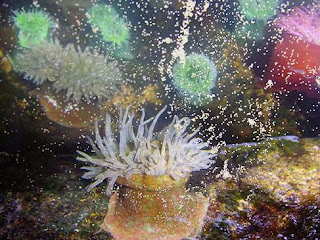Hi Sea Fans!
Reading the paper today made me realize that it can't be said enough: YOU NEED TO BE CAREFUL WHEN IN AND AROUND THE SEA. More and more people are being swept out to sea by currents and being taken by surprise by the strength of the sea. With the holiday season coming up...and many school kids on study breaks, there will be an increased number of people on the beaches and in the sea so I thought I'd write a little note on sea safety.
Swimming
 |
| Durban, South Africa on New Year's Day. (Photo: H de Maine) |
Before entering the sea, take time to watch the waves and avoid areas of strong backwash, obvious rip currents and other dangers such as the possibility of being washed up onto the rocks. Remember that rocks can also be very slippery with algae growth so be careful when entering rock pools. Only enter the sea where the waves are gentle and straight and stay in a comfortable depth for your ability. Remember to keep a look out for lifeguard flags and to stay within the red and yellow flags that they put on the beach for your safety.
If you get carried out to sea by a rip current, don't fight it, swim parallel to the shore and then surf in with the waves once you're out of the current. Backwash and rip currents aren't as strong when the tide is rising, so if you want to play it safe, rather swim at this time.
Lastly, don't dive into shallow water and play safely!
Surfing/paddling
 |
| Surfer (Photo: Stan Shebs) |
Go out with a buddy, you never know when you might need a little help. Keep away from swimming areas and know your own strength and ability.
Snorkelling
 |
| Snorkeller (Photo: Masato Ikeda) |
Go out with a buddy. The most dangerous part of snorkelling is often the entry and exit, choose a safe entry and exit point where you won't get bashed about by the waves or slip on the rocks when entering. Remember to wear something bright like a brightly coloured rash vest or carry a buoy (best option). Without realising it, you can get really badly sunburnt whilst snorkelling, so protect yourself with sun cream and a rash vest or wetsuit.
Boating
 |
| Dive boat (Photo: H de Maine) |
Remember to take a wind-proof jacket with, especially for sunset cruises, as temperatures can drop out at sea quite quickly and with the increased wind, your core body temperature can drop and this can lead to more severe problems like hypothermia. Always check to ensure that you have your safety equipment on board (life jackets, distress flares, anchors and ropes, first aid kit, tool kit, oar/paddle etc) and if you are diving, the skipper must ensure that the diving flag is visible to other sea goers. Listen to your skipper and be alert when launching and beaching.
Wildlife
This is the one that most people are wary of. There is no need to be completely terrified, just be aware.
Jellyfish (especially box jellyfish season in Australia): rather don't swim when they are in their masses.
 |
| Box Jellyfish (Photo by GG). |
Sharks: they don't want to eat you but be alert to warnings from lifeguards as to the presence of sharks (Cape Town, South Africa has flags that are raised at the beaches more prone to shark visits and depending on the colour of the flag, you'll know if the sharks are there, if you should stay out of the water or if no sharks have been spotted that day).
 |
| Ragged Tooth Shark (Photo: H de Maine) |
Lionfish/Devil Firefish: the general rule applies, if you don't disturb them, they won't disturb you.
 |
| Lionfish (Photo: H de Maine) |
Other: try not to step on any unsuspecting creatures, they may not hurt you (some may) but you'll hurt them. Shuffling your feet through the sand will disturb any bottom-dwelling creatures and ensure that you don't stand on them. Don't pick sea creatures up and take them home, they are home already. Have fun checking out the rock pools, but don't shove shells into anemones to see the tentacle retract and don't remove an octopus out of his hole to show friends. You wouldn't want intruders in your home poking and prodding you, so observe them and show others, but don't disturb them.
That's my bit for today Sea Fans. Enjoy the sea, have fun on the beaches and soak up the sun but please be careful and stay safe.
Have a great weekend.
Cheers
Abby
}( *)8
PS. Capetonians: Kirstenbosch Market this Sunday 9am - 3pm, come and say hi.
















































